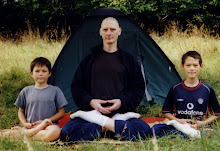Being a hungry ghost in search of solid ground, I sailed from Tokyo to the Pacific island of Okinawa in April 1982, and landed at the karate-dojo of Sensei Morio Higaonna, Chief Instructor of the International Okinawan Goju-Ryu Federation. Higaonna Sensei was a devotee of traditional karate-do, based on traditional forms called kata. One kata was emphasized as particularly important, and that was sanchin kata. Higaonna Sensei described this practice as kihon no naka no kihon -- basic to that which is basic.

To practice sanchin kata under the watchful eye and incredibly powerful and communicative hands of Higaonna Sensei, which is what I am doing in the above photo, was one of the most grounding and awakening experiences my vestibular/proprioceptive system has ever had.
After one such training session, I got a lift on the back of the motorbike of a fellow trainee to the English language bookshop in Okinawa, where I spotted this:

The title appealed strongly to the hungry ghost in me: it hinted at a promise of certainty, security, as to what the fundamental rules of Zen were.
Then, when I opened the book and saw two photos of Master Kodo Sawaki sitting bolt upright in the full lotus posture, head shaved, clothed immaculately in a traditional kasaya, I did not need to read a single word. I proceeded directly to the till.
.JPG)
.JPG)
Back at the hotel where I was staying, I started to try following the instructions that the book set out, and showed the book to my friend and mentor in karate-do, David Essoyan, and even took a photo of him reading it (note the evidence of recent work on punching board on David's first two knuckles!).
.JPG)
David's eyes in the photo are the eyes of a man who has befriended, has taken under his wing, and is looking directly at, a hungry ghost. I was a hungry ghost then, just beginning its sitting-zen life, and I am a hungry ghost now with 26 years of sitting-zen behind me. The main difference between my state then and my state now is that I am much more clear than I was about what the fundamental basis of the state of the hungry ghost is.
A pioneer in the field of occupational therapy named A.Jean Ayres, in her book Sensory Integration and the Child, coined the phrase "gravitational insecurity." When I met Peter Blythe of INPP Chester in 1998, Peter clarified for me the connection between this state of gravitational insecurity, familiar to hungry ghosts everywhere, and aberrance of the baby balance reflex or, to give it its scientific name, the tonic labyrinthine reflex (TLR).

When, during my training at INPP Chester, I tested my father for immaturity of the TLR, by moving his head backward and forward, he coped quite well with his eyes open. But when I asked him to close his eyes and tilted his head backwards, he simply fell over, as if he had drunk 12 pints of beer. Aberrance of this vestibular reflex, the TLR, it seems, is a genetic trait of the Cross family.
Quod Erat Demonstrandum

No comments:
Post a Comment